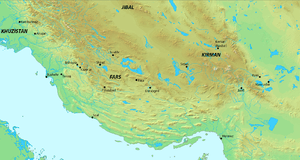Shabankara
Shabankara or Shabankareh (Persian: ملوک شبانکاره, other spellings: Shabankara, Shwankara, Marco Polo: Soncara, Ibn Athir: Shwankara) was the name of a tribal federation of Iranian nomads who resided some parts of the Zagros mountains. They claimed descent from the mythical Iranian king Manuchehr, and are thought to be descendants of Daylamites who had followed the Buyid dynasty from northern Iran, or "Kurds" (a generic late-Antiquity non-ethnic term for Iranian nomads)[1] who had been deported to eastern Fars from Isfahan by the Buyid shahanshah 'Adud al-Dawla (r. 949–983).[2] The dynasty's capital was Ij (Ig).
In the early twelfth century there were five subdivisions of them: Ramani, Shakani, Karzuwi, Masudi and Ismaili.
History

The Ramanid branch of the Shabankara rose in power with their chief Fadluya. He was the son of the Shabankara chief Ali bin al-Hassan, and rose to the ranks of the Buyid Army, in the service of Sahib-i Adil, the vizier of the Buyid king of Fars. Sahib-i Adil was put on death by the last Buyid of Fars, Abu Mansur Fulad Sutun, and Fadluya rose in rebellion after this. Abu Mansur was defeated and murdered with his mother in 1062. The Shabankara chief, now ruler of Fars, soon came into collision with the Seljuk Turks. Fadluya submitted to Qawurd, brother of sultan Alp Arslan, but afterwards revolted. Fadluya was finally captured and executed in 1071 by the Seljuk vizier Nizam al-Mulk. The Shabankara were a nuisance in the provinces of Kerman and Fars. In 1099, with the help of the son of Qawurd, Iran Shah, they defeated the wali of Fars, Amir Unar. In 1116, the Shabankara chief Abu-al Hasan Khuzraw refused to pay homenage to the new governor of Fars, Fakhr al-din Cawuli. Cawuli besieged Khuzraw in his fortress, but came on terms with him later. Khuzraw accompanied the governor in his campaigns in Kerman. In the time of the Sekjuk sultan, Mahmud II (1117-1131), the Shabankara were illtreated and revolted again, bringing great damage to the area. The founder of the Hazaraspid dynasty, Abu Tahir ibn Muhammad, defeated the Shabankara and gained great prestige for this. After collapse of Seljukids, Shabankara ruled again the area with Shahre-Idaj as their capital. In Ilkhanid era they ruled Shabankareh province centered at Darabgird.[3]
The Shabankara chief Kutb-al din Mubariz and his brother Nizam al din Mahmud conquered Kerman in 1201 from the Oghuz Turks, but lost it to a local rebellion and an oghuzz counter-offensive. Finally the atabeg of Fars, Sad ibn Zengi defeated the Shabankara.
In 1260, the Mongol invasor Hulegu destroyed Ig and killed the Shabankara chief Muzaffar al-Din Muhammad ibn al-Mubariz in 1260. In 1312, the Shabankara rebelled against the Ilkhans but were defeated. In 1355, the Muzzafarid Mubariz al din send his son Mahmud against the chief Ardashir, who refused to follow his orders. The chief was defeated and his country was taken by the Muzzafarid. It is possible that the Shabankara has local power until 1424.
List of rulers
- Fadluya (1030-1078)
- Abu'l-Abbas ibn Fadluya Hasanuya (1062-1069)
- Nizam al-Din Mahmud (1068-1080)
- Mubaraz ad-Din Hazarasp (ca. 1080-ca. 1110)
- Hasanwayh I (about 1110-c. 1160)
- Mubaraz I (1160-c. 1190)
- Muhammad Muzzafar (about c.1190-1260)
- Kutb al-Din Mubariz II (1260-1261)
- Nizam al-Din Hasanwayh II (1261-1264)
- Nusrat al-Din Ibrahim (1264-1266)
- Tayyibshah (1264-1282)
- Baha al-Din Ismail (1282-1290)
- Nizam al-Din (1290-c.1310)
- Ardashir (c.1310 (?)-1355)
References
- Potts 2014, p. 159–160.
- Potts 2014, p. 166.
- Christensen 1993, p. 316.
Sources
- Büchner, V.F. & Bosworth, C.E. (1960–2005). "S̲h̲abānkāra". The Encyclopaedia of Islam, New Edition (12 vols.). Leiden: E. J. Brill.
- Christensen, Peter (1993). The Decline of Iranshahr: Irrigation and Environments in the History of the Middle East, 500 B.C. to A.D. 1500. Museum Tusculanum Press. pp. 1–351. ISBN 9788772892597.CS1 maint: ref=harv (link)
- Bosworth, C. E. (1975). "Iran under the Buyids". In Frye, R. N. (ed.). The Cambridge History of Iran, Volume 4: From the Arab Invasion to the Saljuqs. Cambridge: Cambridge University Press. pp. 250–305. ISBN 0-521-20093-8.CS1 maint: ref=harv (link)
- Nagel, Tilman (1990). "BUYIDS". Encyclopaedia Iranica, Vol. IV, Fasc. 6. London u.a.: Routledge & Kegan Paul. pp. 578–586.CS1 maint: ref=harv (link)
- Brill (1993). E. J. Brill's First Encyclopaedia of Islam, 1913-1936, Bind 4. pp. 1–611. ISBN 9004097902.CS1 maint: ref=harv (link)
- Potts, Daniel T. (2014). Nomadism in Iran: From Antiquity to the Modern Era. London and New York: Oxford University Press. pp. 1–558. ISBN 9780199330799.CS1 maint: ref=harv (link)
